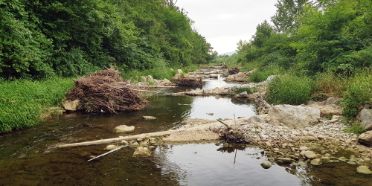Structural measures in hydraulic engineering projects
The current state of knowledge on structural measures in hydraulic engineering projects will be brought together and made available to specialists in the form of a handbook and technical sheets.
Factsheet
- Schools involved School of Architecture, Wood and Civil Engineering
- Institute(s) Institute for Infrastructure and Environment IIU
- Research unit(s) Water and Natural Phenomena group FGWN
- Strategic thematic field Thematic field "Sustainable Development"
- Funding organisation Schweizerische Eidgenossenschaft (Bundesverwaltung)
- Duration (planned) 15.07.2023 - 31.05.2025
- Head of project Prof. Dr. Jolanda Jenzer Althaus
-
Project staff
Gianluca Flepp
Ivo Gasparini
Fabien Waridel -
Partner
Wasser-Agenda 21
PraxisNatur Hartmann
Kanton Basel-Stadt
Emch + Berger AG
Holinger AG
IUB Engineering AG
Aquabios GmbH
Sieber & Liechti GmbH
WFN - Wasser Fisch Natur AG
NH Baumanagement AG
Schweizerisches Kompetenzzentrum Fischerei SKF - Keywords Hydraulic engineering, structuring measures, flood control, ecology, revitalisation
Situation
Hydraulic engineering projects are diverse and complex and must meet the requirements of flood control and ecology. Regardless of whether it is a maintenance measure, a flood control or a revitalisation project, the natural state of the watercourse should be maintained or restored. This is often not possible. A lack of space or of flow dynamics prevents the formation of self-dynamic structures, or the formation of such structures would be lengthy in time. In many hydraulic engineering projects, structural measures are therefore used to initiate the river’s own dynamics and promote habitat diversity. The aim of structural measures is to create habitats for flora and fauna that are diverse and appropriate for the area. Well-designed structures allow scours to form, turbulence is encouraged, and there is variability in terms of flow velocities and water depths. The way in which the desired structural measures are implemented is fundamental, since it ensures that the structures and habitats develop effectively and are accepted by the biotic communities. Successful examples have been documented. Yet, what is has been missing so far is an overall view of the structural measures that lead to a desired ecological effect without jeopardising flood control.
Course of action
As part of the project, the researchers compiled the current state of knowledge on structural measures in hydraulic engineering projects. To this end, examples that have been successfully implemented (best practices) throughout Switzerland were collected and documented. Unsuccessful examples were also listed to avoid renewed mistakes in practice. The project incorporates different perspectives (hydraulic engineering, fisheries and nature conservation). Structural measures are not suitable in all hydraulic engineering projects. Therefore, the BFH project lays down the requirements and the methods that are recommended for each examined structural measure, or if no such intervention is advisable.
Result
On the one hand, the project produced a handbook that clearly summarises the key findings and provides important background information. Furthermore, building type sheets were developed for selected structural measures in order to support their targeted and flood-safe use in hydraulic engineering projects. They present ideas and inspiration for planning, whilst also pointing out important facts that need to be considered during planning and execution on the site. In addition, a web-based collection of case studies with practical examples that have been implemented in recent years is made available. In this way, experience can be passed on.
Looking ahead
The instruments developed are available on the renaturation platform, ‘Plattform Renaturierung’. This is an information platform for the renaturation of water bodies under Water Agenda 21. It is financially supported by the Federal Office for the Environment (FOEN). The platform serves the exchange of information, experience and knowledge. It is aimed at specialists who deal with renaturation measures on bodies of water. The platform is maintained and continuously developed by Water Agenda 21.

